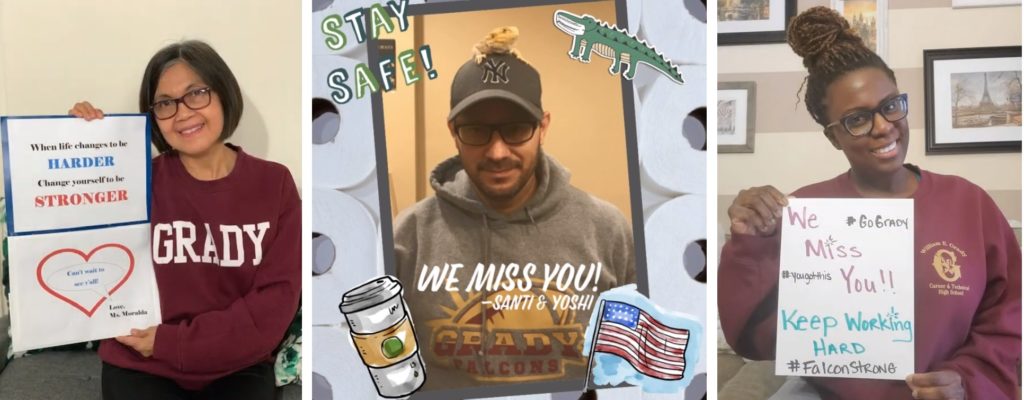
Source: YouTube
The transition to virtual learning has not been easy for any New York City schools since all were shut down in mid-March in response to the COVID-19 pandemic, but the city’s 130 Career and Technical Education (CTE) schools face unique challenges.
For schools like Brooklyn’s William E. Grady High School, navigating new ways of tracking attendance remotely while teaching industrial skills that depend on hands-on training is a particular challenge.
Students in the Brighton Beach school learn automotive skills by working on cars suspended above their heads. They build full-scale houses inside huge classrooms, and cook restaurant style meals in its well-stocked kitchens.
“It’s not easy to go from learning real life technical skills in person to everything on a computer screen inside your tiny apartment,” said Principal Tarah Montalbano. “Grady already had some attendance issues before the school shutdown, so we knew it would be a challenge to get students to show up to online classes.”
Successfully graduating seniors with their skills and industry certification in order pose an extra difficulty. CTE students are required to pass all coursework plus a three-part in-person technical assessment. In addition, a CTE industry certification exam given in June insures that students are qualified for employment. New York State cancelled all exams this year due to the health crisis, including the in-person technical assessment. The Board of Regents may exempt students from the requirement just this year, depending on if individual schools deem their knowledge and skills fit. But the certification is still up in the air.
By not receiving industry-recognized credentials, graduates will leave school more disadvantaged in the hiring process than those in other years. NYSED announced, however, that students on track to sit tests this summer have the option of returning to school to complete their technical preparation in the future. Whether students will actually be inclined to return after graduation is unclear.
Without the possibility of industry certification and hands-on training that leads to jobs, there is less incentive to attend classes. In an effort to keep students showing up and engaging in their virtual classes, Grady officials made the unique decision to shorten the school day.
“We’ve tried to remove the burden of sitting in front of a screen for an entire normal school day,” Montalbano said. “It’s hard for anyone, let alone teenagers, to keep their eyes locked on a screen for so many hours.”
Beginning on Monday, March 23, 2020, students at Grady logged in to their Google Classrooms at 9 a.m. and attended all of their regular classes in a modified bell schedule sent out to all families three days earlier. This new schedule cut the hours of the school day, making each class of the total eight periods in a day last just 25 minutes and end shortly after noon. Since then, the only new change has been the addition of extra help hours three days a week for those who request it.
The principal opted to use software called Pupilpath to keep track of attendance every class period. Each student logs in, receives a “stamp” at the beginning of the class, and is expected to remain logged in for the duration. During the shortened class times, teachers provide direct instruction and assign work to be completed independently offline.
As an incentive to boost attendance, Montalbano also decided that grades will depend more heavily than before on class participation. Engaging in class discussions during live instruction sessions now counts for 40 percent of students’ grade across the school. Measuring participation is left to the discretion of teachers. The remaining 60 percent will be based on graded assignments.
Instruction varies from teacher to teacher. Some provide pre-recorded lectures, some video chats, others PowerPoints and printed notes. Crafting curriculum has been especially challenging for teachers at Grady, who are used to giving their students hands-on work-based learning lessons.
Still, CTE teachers have found creative ways to keep engagement up in their classes. During culinary arts class time, students whip up soufflés with the common ingredients found in their refrigerators. In nursing class, students are tasked with practicing bandaging techniques on their parents or siblings.
In a heartfelt surprise effort to make students at Grady feel even more connected to the school outside of classes while stuck at home, teachers and staff members put together a photo montage of them holding up signs of encouragement and sent it to their students. Maggie, Grady’s therapy dog, posed in one photo. The school’s unofficial mascot, a pet bearded dragon named Yoshi, sat atop construction teacher Jose Santiago’s head in another. Bill Withers’ “Lean on Me” softly rang out in the back. Science teacher Elsa Moralda held up two pieces of paper with red and blue lettering and giant heart.
“When life changes to be harder, change yourself to be stronger,” she wrote. “Can’t wait to see y’all! Love, Ms. Moralda.”



